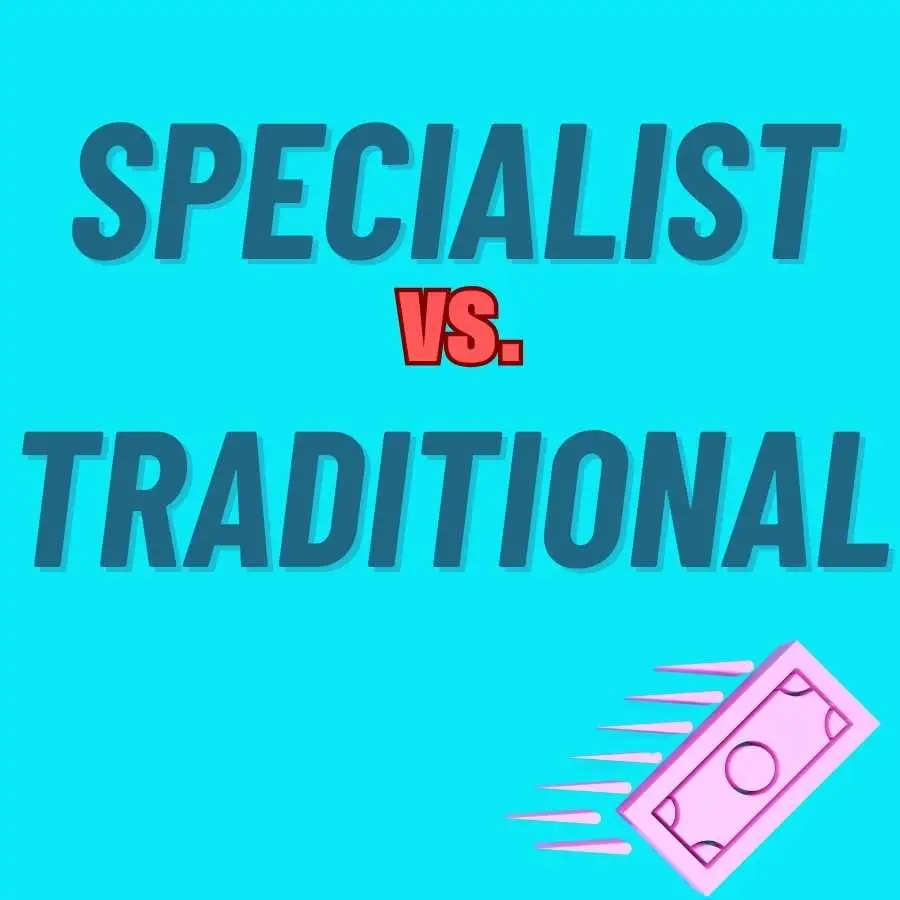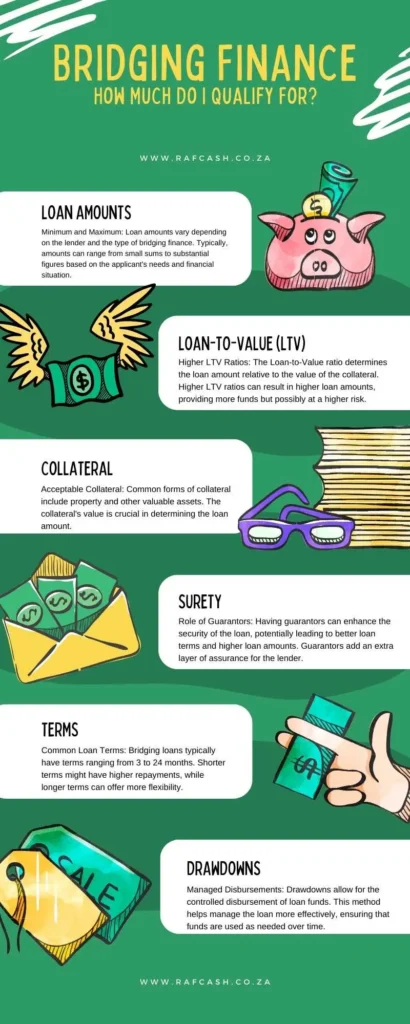In South Africa’s dynamic property and business markets, the ability to access funds quickly can make all the difference.
Whether you’re a property investor seizing a prime opportunity or a business owner navigating a cash flow shortfall, timely financing is crucial.
Fast bridging loans, also known as bridge finance loans, provide an effective solution to these urgent financial needs.
Fast bridging loans are short-term financing options designed to cover immediate expenses until longer-term financing can be arranged.
These loans bridge the gap between the need for quick cash and the arrival of permanent funding, making them an essential tool for those facing time-sensitive financial situations.
The significance of quick bridging finance lies in its ability to provide rapid access to funds, enabling individuals and businesses to capitalize on opportunities, manage urgent expenses, and maintain financial stability.
By offering a swift, flexible, and reliable source of short-term funding, fast bridging loans ensure that financial gaps are bridged seamlessly, allowing for uninterrupted progress and growth.
What Are Fast Bridging Loans?
Definition
Fast bridging loans, also known as bridge finance loans, are short-term financing solutions designed to provide immediate funds to cover temporary cash flow gaps.
These loans are typically used to bridge the period between two significant financial transactions, such as the purchase of a new property before the sale of an existing one.
Bridging loans are secured against property or other valuable assets, ensuring that borrowers can access the necessary funds quickly and efficiently.
Types
There are two main types of bridging loans: closed bridging loans and open bridging loans.
- Closed Bridging Loans: These loans have a fixed repayment date, usually tied to a known event such as the completion of a property sale. Closed bridging loans are typically used when there is a high degree of certainty about the repayment source and timing, making them less risky for lenders and often resulting in lower interest rates.
- Open Bridging Loans: Open bridging loans do not have a fixed repayment date. Instead, they are more flexible, allowing borrowers to repay the loan as soon as their funds become available. This type of loan is often used when the exact timing of the repayment source is uncertain. While open bridging loans offer greater flexibility, they may come with higher interest rates due to the increased risk for lenders.

Comparison with Traditional Loans
Fast bridging loans differ from traditional loans in several key ways, particularly in terms of speed and flexibility.
- Speed: One of the primary advantages of fast bridging loans is the quick access to funds. Traditional loans, such as mortgages or personal loans, often involve lengthy application processes, extensive documentation, and rigorous credit checks. In contrast, fast bridging loans can be approved and disbursed within days, making them ideal for urgent financial needs.
- Flexibility: Bridging loans offer greater flexibility compared to traditional loans. They can be tailored to suit various financial situations, including property purchases, business cash flow gaps, and covering unexpected expenses. The terms of bridging loans, including the loan amount, repayment period, and interest rates, can be customized to meet the specific needs of the borrower. Traditional loans, on the other hand, often come with rigid terms and conditions, limiting their suitability for short-term and urgent financial requirements.
Fast bridging loans provide a swift, adaptable, and effective solution for individuals and businesses facing immediate financial challenges, enabling them to bridge the gap between short-term needs and long-term financial stability.

How Do Fast Bridging Loans Work?
Application Process
Applying for a fast bridging loan in South Africa is designed to be a streamlined and efficient process, allowing borrowers to access funds quickly. Here’s a step-by-step guide to help you through the application process:
- Initial Consultation: Contact a reputable bridging finance provider to discuss your financial needs and determine if a bridging loan is suitable for your situation.
- Submit Application: Complete an application form provided by the lender. This can often be done online for convenience.
- Provide Documentation: Gather and submit the necessary documents to support your application. This helps the lender assess your eligibility and expedite the approval process.
Required Documentation
To ensure a smooth and swift application process, you will need to provide the following documents:
- Proof of identity (e.g., ID or passport)
- Proof of address (e.g., utility bill or bank statement)
- Details of the property being used as collateral (e.g., title deed, valuation report)
- Sale agreement or proof of pending sale (if applicable)
- Proof of income or financial statements
- Any additional documents requested by the lender
Efficient Conveyancing
Engaging a skilled conveyancer is crucial in speeding up the bridging loan process.
Conveyancers handle the legal aspects of property transactions, ensuring that all necessary paperwork is completed accurately and promptly.
Their expertise can help prevent delays and ensure that the funds are released as quickly as possible.

Approval Time
The approval time for fast bridging loans can vary, but it is typically much quicker than traditional loan approvals. On average, borrowers can expect:
- Initial response within 24-48 hours
- Formal approval within 3-7 days, depending on the complexity of the application and the efficiency of document submission
Working with a reputable lender and ensuring all required documentation is provided promptly can significantly reduce approval times.
Repayment Terms
Fast bridging loans offer flexible repayment terms tailored to the borrower’s financial situation and the specific nature of the loan.
Here are the common repayment structures:
- Lump Sum Repayment: The loan is repaid in full at the end of the term, including the principal amount and any accrued interest. This is typical for closed bridging loans where the repayment date is known and tied to a specific event, such as the sale of a property.
- Monthly Interest Payments: Borrowers may choose to make monthly interest payments throughout the loan term, with the principal amount repaid at the end. This option helps manage cash flow and reduces the final repayment burden.
- Rolled-Up Interest: Interest is accrued and added to the loan balance, with the total amount repaid at the end of the term. This option is useful for borrowers who prefer not to make monthly payments and can afford a larger lump sum repayment at the end.
Fast bridging loans are designed to provide quick and flexible financial solutions, enabling borrowers to bridge short-term cash flow gaps effectively.
By understanding the application process, approval timelines, and repayment terms, you can make informed decisions and secure the funding you need swiftly.
Benefits of Fast Bridging Loans
Speed
One of the most significant advantages of fast bridging loans is the rapid access to funds they provide. Traditional loans can take weeks or even months to process, with extensive paperwork and rigorous credit checks.
In contrast, fast bridging loans are designed for speed, often providing initial approval within 24-48 hours and full funding within a few days.
This quick turnaround is crucial for individuals and businesses facing urgent financial needs, such as seizing a time-sensitive property purchase or covering unexpected expenses.
Flexibility
Fast bridging loans offer a high degree of flexibility, making them suitable for a wide range of financial situations. Some common use cases include:
- Property Purchases: Bridging loans can be used to quickly secure a new property before selling an existing one, avoiding the pitfalls of property chains.
- Business Cash Flow: Companies can use bridging loans to manage short-term cash flow gaps, ensuring smooth operations during periods of financial strain.
- Debt Consolidation: Borrowers can use the funds to consolidate high-interest debts into a single, more manageable payment.
- Renovations and Refurbishments: Homeowners and property developers can access funds quickly to finance renovations or refurbishments, enhancing property value before a sale.
The ability to tailor the loan terms, such as repayment schedules and loan amounts, to suit specific needs further enhances the flexibility of fast bridging loans.

Short-Term Financing
Fast bridging loans are particularly well-suited for short-term financing needs, where long-term loans or mortgages would be impractical or unnecessary.
Ideal scenarios for using fast bridging loans include:
- Auction Purchases: When buying property at auction, buyers typically need to complete the purchase within a short timeframe. Bridging loans provide the necessary funds quickly, allowing buyers to meet auction deadlines.
- Property Chain Breaks: If a property sale falls through and disrupts the purchase of a new property, a bridging loan can provide the interim financing needed to keep the transaction on track.
- Business Opportunities: Companies can take advantage of sudden business opportunities, such as purchasing discounted inventory or equipment, without waiting for long-term financing to be approved.
- Covering Legal Settlements: Individuals awaiting settlements from legal claims, such as Road Accident Fund claims, can use bridging loans to access funds immediately while waiting for the final payout.
Fast bridging loans bridge the gap between immediate financial needs and long-term financing solutions, providing a quick, flexible, and effective means of managing short-term cash flow challenges.

How Much Do I Qualify For?
Minimum and Maximum Loan Amounts
In South Africa, the typical ranges for fast bridging loan amounts can vary significantly based on the lender and the borrower’s needs.
Generally, bridging loans can start from as little as R50,000 and go up to several million rands.
Some lenders may even offer loans up to R50 million or more, depending on the asset value and the borrower’s financial situation.
Loan-to-Value (LTV)
Loan-to-Value (LTV) ratios play a crucial role in determining the amount you can borrow through a bridging loan. The LTV ratio is the percentage of the property’s value that the lender is willing to loan.
For example, if a property is valued at R1 million and the lender offers an LTV of 70%, you could borrow up to R700,000.
LTV ratios typically range from 50% to 80%, depending on factors such as:
- Property Type: Residential properties might attract higher LTVs compared to commercial properties.
- Borrower’s Creditworthiness: A higher credit score may result in a higher LTV.
- Market Conditions: Stable market conditions can lead to higher LTV offerings.
Security or Collateral
Bridging loans are secured loans, meaning they require collateral to mitigate the lender’s risk. Common types of acceptable collateral include:
- Real Estate: Residential, commercial, or industrial properties.
- Equity in Property: Existing equity in a property can be used as collateral.
- Other Valuable Assets: In some cases, lenders may accept other high-value assets such as vehicles, equipment, or even shares in a company.
The value and type of collateral significantly impact the loan amount and terms offered by the lender.
Surety
In addition to collateral, some lenders may require a guarantor or surety to further secure the loan.
A guarantor is someone who agrees to repay the loan if the primary borrower defaults.
This provides additional security for the lender and can improve the borrower’s chances of securing the loan, potentially at better terms.
Term
Bridging loans are designed as short-term financial solutions. Common loan terms range from a few weeks to 24 months.
The specific term depends on the borrower’s needs and the lender’s policies. For instance:
- Short-Term Needs: Loans for a few weeks to six months are suitable for quick property flips or auction purchases.
- Longer-Term Requirements: Loans extending up to 24 months may be used for more extensive property renovations or business cash flow management.
Drawdowns
Drawdowns refer to the process of disbursing loan funds. In some cases, borrowers may not require the entire loan amount upfront.
Instead, they can draw down funds in stages, as needed. This approach offers several benefits:
- Interest Savings: Interest is only charged on the amount drawn down, not the total loan amount, potentially reducing overall interest costs.
- Cash Flow Management: Staged drawdowns help manage cash flow more effectively, ensuring funds are available when needed without incurring unnecessary interest charges.
Understanding these elements helps borrowers determine how much they can qualify for and manage their bridging loan effectively to meet their financial needs.

Eligibility Criteria for Fast Bridging Loans
Credit Score
One of the key factors lenders consider when evaluating an application for a fast bridging loan is the applicant’s credit score.
While bridging loans are more flexible compared to traditional loans, having a good credit score can still significantly impact your eligibility and the terms of the loan.
Generally, a credit score of 600 or higher is preferred by most lenders.
However, some lenders are willing to work with borrowers who have lower credit scores, especially if they can provide strong collateral or a solid exit strategy.
Income Proof
Providing proof of income is another essential criterion for securing a fast bridging loan.
Lenders need to be confident in the borrower’s ability to repay the loan.
The following income documentation is typically required:
- Recent Pay Slips: For salaried individuals, the last three months’ pay slips are usually sufficient.
- Bank Statements: Six months’ bank statements to show consistent income flow.
- Financial Statements: For self-employed individuals or business owners, financial statements such as profit and loss statements, balance sheets, and recent tax returns may be required.
- Additional Income Proof: Any additional sources of income, such as rental income or dividends, should also be documented and provided to the lender.
Collateral
Collateral is a crucial aspect of securing a bridging loan, as these loans are primarily asset-based.
The types of acceptable collateral include:
- Real Estate: Residential, commercial, or industrial properties are the most common forms of collateral. The property can be one that the borrower currently owns or is in the process of purchasing.
- Equity in Property: If the borrower has significant equity in an existing property, this can be used as collateral.
- Valuable Assets: Other high-value assets such as vehicles, machinery, or equipment may also be considered, though this depends on the lender’s policies.
- Investment Portfolios: Stocks, bonds, or other investments can sometimes be used as collateral if they meet the lender’s criteria.
By understanding and meeting these eligibility criteria, borrowers can improve their chances of securing a fast bridging loan and accessing the funds they need promptly.

Choosing the Right Fast Bridging Loan Provider
Reputation
When selecting a bridging loan provider, it’s crucial to choose one with a solid reputation. Reputable lenders are more likely to offer transparent terms, fair rates, and excellent customer service.
Research potential lenders by reading reviews, checking their regulatory status, and seeking recommendations from trusted sources.
Interest Rates
Comparing interest rates is essential to ensure you get the best deal. Different lenders offer varying rates, and it’s important to understand both the nominal interest rate and the effective rate, which includes all fees and costs associated with the loan.
Look for lenders who provide clear and detailed information about their rates and any additional charges.
Customer Service
Excellent customer service can make a significant difference in your borrowing experience. Choose a lender known for responsive, helpful, and professional service.
Good customer service ensures smooth communication, quick responses to queries, and support throughout the loan process.

Short-Term Loan Providers in South Africa
Here are some of the leading short-term finance companies in SA which you might want to check out.
Marlin Credit: Offers bridging finance solutions for individuals awaiting lump sum payouts from pensions, provident funds, property sales, and other financial settlements.
Genfin: Provides business funding solutions, including Opportunity Bridge Loans, Large Business Loans, and Small Business Loans, aimed at businesses with annual turnovers starting from R1 million.
Green Door Bridging Finance: Specializes in pension bridging loans for individuals awaiting retirement annuity payouts, focusing on efficient service.
Lula Bridging Finance: Offers fast and flexible bridging finance for SMEs in South Africa, providing funding within 24 hours to manage cash flow and operational costs.
Lamna: Provides bridging finance for individuals awaiting property transfer funds or Road Accident Fund (RAF) payouts, offering quick access to a portion of the expected settlement.
Geddes Capital: Offers short-term bridging finance solutions for South African businesses needing quick cash flow, secured by property.
Bridgement: Provides fast and flexible funding solutions for SMEs, offering business loans, lines of credit, and invoice finance to improve cash flow and support growth.
Rodel Bridging Finance: Offers short-term financial solutions in the real estate sector, including advances for property sales, arrear rates, estate agent commissions, and property developments.
Prevance: Specializes in property bridging finance, offering solutions like short-term business loans, development finance, and advances for property sellers and real estate agencies.
Did you know...
- Speed of Funding: Fast bridging loans can often be approved and funds disbursed within 24 to 48 hours, making them one of the quickest financing options available.
- Flexible Uses: Bridging finance is versatile, allowing you to cover a wide range of needs such as property purchases, business cash flow gaps, and even personal expenses.
- High LTV Ratios: Bridging loans in South Africa typically offer Loan-to-Value (LTV) ratios up to 75%, allowing borrowers to access a significant portion of their property’s value.
- Interest Rate Options: Bridging loans can feature both simple and compound interest, impacting the total cost of borrowing depending on the loan structure.
- Case Study Success: Bridging finance has facilitated numerous successful transactions in major South African cities like Johannesburg, Cape Town, and Umhlanga, highlighting its effectiveness in various scenarios.
- Collateral Flexibility: Acceptable collateral for bridging loans isn’t limited to just property; it can also include other assets, broadening the accessibility of these loans.
- Short-Term Solution: Bridging loans are specifically designed for short-term needs, with typical loan terms ranging from 3 months to 3 years.
- Market Responsiveness: The flexibility and speed of bridging loans make them ideal for taking advantage of market opportunities that require quick action, such as purchasing auction properties.
- No Hidden Fees: Reputable lenders often ensure transparency with no hidden fees, providing clear information on all costs involved in the loan.
- Principal Lenders Advantage: Working with principal lenders like BFS can speed up the loan process significantly, as they use their own funds and can make quick decisions.
How Fast Can You Get Bridging Finance in South Africa?
Typical Timeframes
Obtaining fast bridging finance in South Africa can vary depending on the lender and the specifics of your financial situation.
However, on average, the process can be broken down into several stages:
- Application Submission: The initial application can typically be completed online in just a few minutes.
- Documentation Review: After submitting the necessary documents, lenders usually review and verify the information within 24 to 48 hours.
- Approval and Offer: Once the documentation is reviewed, lenders can provide a decision in principle (DIP) within 24 hours. Some lenders boast even quicker turnaround times, offering DIPs in as little as 8 minutes.
- Fund Disbursement: Upon approval and acceptance of the loan offer, funds can be disbursed within 24 to 72 hours, depending on the lender’s processes and any additional requirements such as property valuations.
Overall, the entire process from application to receiving funds can take anywhere from a few days to a week, making bridging finance one of the fastest ways to access funds.
Principal Lenders
Principal lenders offer several benefits that can speed up the process:
- Direct Lending: As principal lenders use their own funds, they do not need to consult third parties before making lending decisions, which significantly reduces waiting times.
- Streamlined Processes: These lenders often have established procedures to expedite application reviews, approvals, and fund disbursements.
- Regulated Operations: Being regulated by bodies like the National Credit Regulator (NCR), they ensure a high level of service and reliability, further facilitating a smooth and quick lending process.

Speeding Up the Process
To accelerate the application and approval process for fast bridging finance, consider the following tips:
- Prepare Documentation in Advance: Gather all necessary documents before starting your application. This typically includes ID, proof of address, financial statements, and details of the property or assets being used as collateral.
- Efficient Conveyancing: Choose a conveyancer with experience in bridging finance. An efficient conveyancer can speed up the property valuation and legal processes.
- Clear Exit Strategy: Presenting a clear and viable exit strategy can reassure lenders and expedite approval. Whether your plan is to refinance or sell a property, having all details ready will help.
- Responsive Communication: Stay in constant communication with your lender and promptly respond to any requests for additional information or documentation.
- Use a Broker: Working with a specialist broker can help navigate the process more smoothly. Brokers have established relationships with lenders and can often push applications through more quickly.
By following these tips and choosing the right lender, you can significantly reduce the time it takes to secure bridging finance, ensuring you have the funds you need exactly when you need them.

Common Uses of Fast Bridging Loans
Property Purchases
Fast bridging loans are a popular solution for various property-related needs due to their quick approval and flexible terms. Common scenarios include:
- Buying Auction Properties: Auction purchases often require immediate payment. Fast bridging loans provide the necessary funds quickly, enabling buyers to secure properties without delays.
- Breaking Property Chains: When selling one property to buy another, delays in the sale can create a financial gap. Bridging loans help by providing funds to complete the purchase of the new property while waiting for the sale proceeds from the old one.
- Renovation Projects: Investors and homeowners use bridging loans to finance property renovations before refinancing or selling at a higher value.
Business Needs
For businesses, fast bridging loans offer critical support in maintaining operations and seizing opportunities:
- Short-Term Cash Flow Gaps: Businesses often face temporary cash flow shortages due to delayed payments from clients or seasonal fluctuations. Bridging loans provide the necessary funds to cover operational costs during these periods.
- Urgent Inventory Purchases: Retailers and manufacturers may need to purchase inventory quickly to meet unexpected demand or take advantage of supplier discounts. Bridging loans enable businesses to make these purchases without disrupting cash flow.
- Expansion Opportunities: Companies looking to expand quickly, whether through new locations, additional staff, or new product lines, can use bridging loans to finance these growth initiatives until long-term funding is secured.
Personal Needs
Individuals also find bridging loans useful for managing personal financial situations that require immediate attention:
- Covering Unexpected Expenses: Sudden expenses, such as medical emergencies or urgent home repairs, can strain personal finances. Bridging loans provide quick access to funds to address these needs promptly.
- Settling Debts: For those needing to consolidate or settle debts quickly, bridging loans offer a fast solution to pay off high-interest debts, potentially saving money in the long run.
- Funding Legal Settlements: Individuals awaiting settlements from legal cases, such as divorce or inheritance, can use bridging loans to access funds before the settlement is finalized.
Fast bridging loans offer a versatile and efficient way to manage financial gaps, whether for property purchases, business needs, or personal expenses.
Their flexibility and speed make them an invaluable tool for addressing urgent financial requirements and taking advantage of time-sensitive opportunities.

What Does It Cost?
Interest Rates
Interest rates for fast bridging loans can vary depending on several factors, including the loan amount, term, and the lender’s policies.
Typically, bridging loan interest rates in South Africa range from 0.5% to 2% per month.
It’s important to compare different lenders to ensure you get the most competitive rate.
Remember, bridging loans are short-term and their interest rates are generally higher than traditional long-term loans due to the quick access to funds and higher risk involved.
Simple and Compound Interest
Understanding the type of interest applied to your loan is crucial:
- Simple Interest: This is calculated only on the principal amount of the loan. For example, if you borrow R100,000 at an interest rate of 1% per month, you’ll pay R1,000 each month in interest, regardless of how long you hold the loan.
- Compound Interest: This is calculated on the principal amount and also on the accumulated interest from previous periods. If the same R100,000 loan is compounded monthly at 1%, you’ll pay interest not only on the initial R100,000 but also on the interest accrued each month, leading to higher total interest payments over time.
Applicable Fees
Several fees can be associated with bridging loans. Understanding these will help you evaluate the true cost of the loan:
- Origination Fees: A fee charged by the lender for processing the loan. This can be a flat fee or a percentage of the loan amount.
- Service Fees: Ongoing fees for managing the loan. These can be monthly or quarterly.
- Exit Fees: Fees charged for early repayment of the loan. Some lenders may also charge an exit fee when the loan term ends.
- Valuation Fees: Costs for property appraisals, which are necessary for securing the loan.
- Legal Fees: Fees for the legal work required to set up the loan agreement.
All-In Cost of Finance (IRR)
The Internal Rate of Return (IRR) is a comprehensive measure of the total cost of borrowing, accounting for interest rates and all associated fees.
Calculating the IRR allows you to compare different loan offers on a like-for-like basis.
To calculate the IRR:
- List all Cash Flows: Identify all cash inflows (loan amount) and outflows (interest payments, fees, and principal repayment) over the loan term.
- Set Up the IRR Calculation: Use the IRR function in financial calculators or spreadsheet software like Excel to compute the rate.
- Compare IRRs: Evaluate the IRRs of different loan offers. The loan with the lowest IRR is generally the most cost-effective.
For example, consider two loans:
- Loan A has a lower monthly interest rate but high upfront and service fees.
- Loan B has a higher monthly interest rate but lower fees.
By calculating the IRR for both loans, you can determine which loan is cheaper overall, taking all costs into account.
Understanding the costs associated with fast bridging loans is essential for making an informed decision.
By considering interest rates, the type of interest, various fees, and using the IRR to compare offers, you can ensure that you choose the most cost-effective financing solution for your needs.

Risks and Considerations
High-Interest Rates
Bridging loans typically come with higher interest rates compared to traditional long-term loans.
This is due to the short-term nature and the speed at which the funds are made available. It’s crucial to understand and manage these costs effectively. High-interest rates can quickly accumulate, making the overall cost of the loan significant if not repaid promptly.
Borrowers should:
- Carefully Compare Rates: Shop around to find the most competitive rates available.
- Calculate Total Costs: Consider the impact of both interest and fees over the loan term.
- Plan for Early Repayment: If possible, repay the loan early to reduce the interest burden, keeping in mind any early repayment fees.
Repayment Risks
Repaying a bridging loan can pose challenges, especially if the expected funds (such as proceeds from a property sale) are delayed or do not materialize.
Potential repayment challenges include:
- Delay in Sale or Financing: If the property sale or long-term financing takes longer than expected, it can be challenging to repay the bridging loan on time.
- Default Risk: Failure to repay the loan can lead to significant penalties and may impact your credit rating.
- Repossession: If the loan is secured against property, failure to repay can result in the lender repossessing the asset.
To mitigate these risks:
- Have a Clear Exit Strategy: Ensure you have a well-defined plan for repaying the loan, such as a confirmed property sale or committed long-term financing.
- Maintain Communication with Lender: Keep an open line of communication with your lender to manage any potential delays and explore possible extensions if necessary.
Market Conditions
Market fluctuations can significantly impact the effectiveness and cost of bridging loans.
Factors to consider include:
- Property Market Volatility: In a declining property market, selling your property at the expected price may become difficult, impacting your ability to repay the loan.
- Interest Rate Changes: Sudden changes in interest rates can increase the cost of borrowing, especially if the loan terms are not fixed.
- Economic Conditions: Broader economic conditions, such as a recession, can affect property prices and the availability of long-term financing.
To navigate these uncertainties:
- Stay Informed: Keep abreast of market conditions and economic trends that could affect your property value or financing options.
- Flexible Terms: Consider loans with flexible terms that allow for adjustments based on market conditions.
- Contingency Plans: Have backup plans in place for alternative financing or delaying property sales if market conditions become unfavorable.
While fast bridging loans offer significant advantages in terms of speed and flexibility, it’s essential to be aware of and manage the associated risks.
By understanding the high-interest rates, preparing for potential repayment challenges, and staying informed about market conditions, borrowers can better navigate the complexities of bridging finance and make informed decisions that align with their financial goals.

Case Studies and Success Stories
Johannesburg Fast Finance
In Johannesburg, the bustling heart of South Africa’s economy, bridging loans have played a crucial role in facilitating property transactions and business expansions.
One notable success story involves a property developer who needed immediate funds to secure a prime piece of real estate in Sandton, the city’s financial district. The developer was awaiting the sale of another property, but the timing didn’t align.
By leveraging a fast bridging loan, he was able to secure the new property, avoiding a missed opportunity.
Once the original property sale was completed, he repaid the bridging loan and proceeded with the development, which is now a thriving commercial hub.

Cape Town Speedy Bridging Loans
Cape Town, known for its scenic beauty and vibrant real estate market, has also seen numerous success stories with bridging finance. A small business owner in the city faced a cash flow crisis just as an important deal was about to close.
The delay in receiving funds from a large invoice threatened to derail the business.
By securing a bridging loan, the owner was able to cover immediate expenses, including payroll and inventory purchases.
This financial lifeline ensured that the business remained operational and even enabled it to take advantage of a bulk purchase discount from a supplier, ultimately increasing profitability.

Umhlanga Quick Property Loan
In the coastal town of Umhlanga, bridging loans have provided crucial support for residential property transactions.
A family looking to purchase their dream home faced a common dilemma: their current house hadn’t sold yet, but they didn’t want to lose out on the new property. They secured a bridging loan to cover the down payment and other immediate costs, allowing them to move forward with the purchase.
Once their old home sold, they used the proceeds to repay the loan. This timely financial intervention made the transition smooth and stress-free, ensuring they didn’t miss out on their desired home in a competitive market.

These stories from Johannesburg, Cape Town, and Umhlanga highlight the transformative power of fast bridging finance.
Whether for commercial property acquisitions, business cash flow management, or residential transactions, bridging loans have proven to be an effective tool in navigating financial gaps and seizing timely opportunities.
Conclusion
Fast bridging loans offer a crucial financial lifeline in South Africa’s dynamic property and business markets. By providing quick access to funds, these loans enable individuals and businesses to seize opportunities that might otherwise slip away due to timing constraints.
The flexibility and speed of fast bridging loans make them an invaluable tool for property purchases, business needs, and covering unexpected personal expenses.
As demonstrated through the success stories in Johannesburg, Cape Town, and Umhlanga, fast bridging finance can be the key to unlocking significant opportunities and navigating financial gaps with ease.
Whether you are a property developer, a small business owner, or an individual in need of immediate funds, bridging loans provide the necessary support to keep your financial plans on track.
If you find yourself in need of quick and flexible financing, consider exploring the benefits of fast bridging loans. Consult with reputable lenders to understand your options and secure the financial support you need to achieve your goals.
The right bridging loan can make all the difference in turning potential setbacks into successful outcomes.

Frequently Asked Questions
What are fast bridging loans?
Fast bridging loans are short-term loans designed to provide quick access to funds while waiting for longer-term financing or the completion of a property sale.
How do fast bridging loans differ from traditional loans?
How do fast bridging loans differ from traditional loans?
What types of fast bridging loans are available?
There are two main types: closed bridging loans, which have a fixed repayment date, and open bridging loans, which do not have a set repayment date but usually need to be paid back within a year.
What documents are required to apply for a fast bridging loan?
Typically, you need identification, proof of income, details about the property or collateral, and a clear exit strategy showing how you will repay the loan.
How quickly can I get a fast bridging loan approved?
Approval times vary but can be as quick as 24 hours to a few days, especially with principal lenders who manage their own funds.
What are the typical uses of fast bridging loans?
They are commonly used for property purchases, business cash flow gaps, urgent inventory purchases, and covering unexpected personal expenses.
How much can I borrow with a fast bridging loan?
Loan amounts typically range from a few thousand to several million rands, depending on the value of the collateral and the lender’s policies.
What is Loan-to-Value (LTV) in bridging finance?
LTV is the ratio of the loan amount to the value of the property used as collateral. Higher LTV ratios mean you can borrow more relative to the property’s value.
What are the costs associated with fast bridging loans?
Costs include interest rates (either simple or compound), origination fees, service fees, and other applicable charges. The overall cost is often measured by the Internal Rate of Return (IRR).
What are the risks of taking out a fast bridging loan?
Risks include high-interest rates, potential repayment challenges, and market fluctuations that could impact the value of the collateral or the ability to secure long-term financing.

Glossary
- Bridging Finance A short-term loan used to cover immediate financial needs while waiting for long-term funding or the completion of a transaction.
- Collateral Assets pledged by a borrower to secure a loan, which can be seized by the lender if the loan is not repaid.
- Closed Bridging Loan A type of bridging loan with a fixed repayment date.
- Open Bridging Loan A type of bridging loan without a set repayment date, typically repaid within a year.
- Loan-to-Value (LTV) The ratio of the loan amount to the value of the property used as collateral.
- Conveyancer A legal professional responsible for managing the transfer of property ownership.
- Exit Strategy A plan for repaying a loan, such as through the sale of an asset or refinancing.
- Origination Fee A fee charged by lenders for processing a new loan application.
- Simple Interest Interest calculated only on the principal amount of the loan.
- Compound Interest Interest calculated on both the principal amount and any previously accumulated interest.
- Internal Rate of Return (IRR) A metric used to evaluate the profitability of an investment, considering all cash flows and costs.
- Principal Lender A lender that uses its own funds to provide loans, without relying on third parties.
- Credit Score A numerical representation of a borrower’s creditworthiness, based on their credit history.
- Guarantor A person who agrees to repay a loan if the original borrower fails to do so
- Drawdown The process of accessing funds from a loan, often done in stages based on the borrower’s needs.





